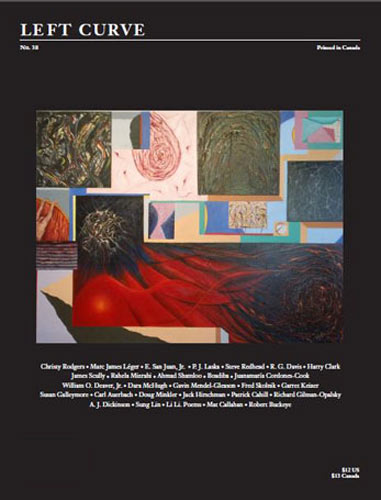Left Curve – 2015
For their final print issue, after the recent passing of their editor and publisher, Csaba Polony, Left Curve provides readers with a strong collection of essays, poetry, and a variety of other musings, including a play and an interview with artists Victor and Margarita Tupitsyn. Although the journal will continue to make use of their website, the final hard copy, like Dylan Thomas suggests in his canonized villanelle, does not go gentle into that good night. The selections are designed, written, and selected by thinkers. For their final print issue, after the recent passing of their editor and publisher, Csaba Polony, Left Curve provides readers with a strong collection of essays, poetry, and a variety of other musings, including a play and an interview with artists Victor and Margarita Tupitsyn. Although the journal will continue to make use of their website, the final hard copy, like Dylan Thomas suggests in his canonized villanelle, does not go gentle into that good night. The selections are designed, written, and selected by thinkers. While the journal has chosen work they say “addresses the problem(s) of cultural forms emerging from the crises of modernity that strive to be independent from the control of dominant institutions and free from the shackles of instrumental rationality,” these pieces will be at home with anyone willing to sit idyll and participate in the freeing activity of thinking.
There is almost no piece more accurately representative of what it means to use one’s brain than Steve Redhead’s article “Scream if you Wanna Go Faster: Sport, Social Media & the Futurism of the Instant.” This short work applies French dromological theories of speed, power and technology—Paul Virilio’s idea of the “city of the instant”—to modern day use of social media and online broadcasting as it relates to sporting events. Redhead explains how the world is capable of viewing the same event instantly from any device with an internet connection while simultaneously discussing that event with others across oceans. The action of taking part in this constant “now” builds this “city of the instant” and skews the human view of time. While we all live in the present, time and distance shrinks due to our continual connection with each other’s present moment through social media devices. This leads to a “city of the instant” where, as Redhead points out in Virilio’s work, the “futurism of the moment” weakens and what is left is a “claustropolitan future,” or lack of privacy, a lost past and a non-existent future.
In conversation with Redhead’s essay, albeit indirectly, is Susan Galleymore’s creative nonfiction piece titled, “Rhythm, Blues and the ABCs of Distress.” In her piece, Galleymore discusses life on a boat. She begins the piece by reading the labels surrounding the boat. She explains how she has taken on life at sea because the current state of modernity has left her looking to get away and slow things down. Using lines from a Bob Dylan song, Galleymore lays out how history has shown us that politicians and the alike continue to bombard us with similar empty rhetoric. Galleymore provides several examples of the things she has read and heard in the news, and muses over how the general populace can continue to eat up what they are served. How and why does this happen? Galleymore provides a possible answer quoting physicist and social theorist David Bohm. It is difficult to think because “‘thinking. . . is fragmentation. . . we select certain things and separate them from others.” Essentially, Galleymore points out that American elitism blurs our ability to see the true problem at hand. Like those living in the “city of the instant,” we want to solve problems quickly without taking into consideration what other problems we may be creating.
Finally, Left Curve provides an array of poetry that grips the reader with unique insight, making up for what it may lack in imagery by finding the seeds of deeper meaning in the poetic form and riding that growth toward the sun.. The staff of Left Curve has done a wonderful job producing a work their late editor would appreciate. Although Csaba Polony took part in selecting some of the pieces in this issue, he was not able to see it published. Rest assured, wherever he may be, the former editor has a work he can be proud of.
[www.leftcurve.org]





